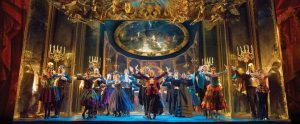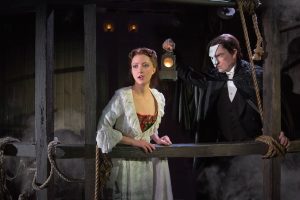Somewhere, the Phantom’s Still At The Opera
Cameron Mackintosh claims that Andrew Lloyd Webber’s The Phantom of the Opera has grossed over $6 billion worldwide and continues to rake it in with eight productions on three continents, including the original in London (28 years) and on Broadway (27 years).
But there’s always room for more.

The Phantom of the Opera company, on tour. No grand staircase but a nice mirror. Alastair Muir Photo
For me, Phantom is a genuine masterpiece of popular theatre, its flaws unimportant, its magic secure, only as long as the genius-level staging of Harold Prince is kept fresh and true. Because this is a rich, thick, dominating spectacle that thrives best within the charmed circle of its origins. It is to be “adjusted” at the peril of he who tries.
Inevitably, of course, that will come to pass. Someday, the East Codswaddle Muzical Showcase will be able to rent the rights and splatter whatever all over the cafetorium. But as long as the London and/or Broadway productions soldier on, the art will survive.
(A few years ago, I arranged to take some youngsters for a backstage look at the touring Phantom company in the Civic Theatre. I was surprised and delighted when the show’s stage manager volunteered himself as our guide. He graciously accepted my thanks, saying that he enjoyed such opportunities. “I consider myself,” he said, “a curator in a first-class museum.” That was a warm moment.)
Anyway, it’s hard to blame Macintosh and Lloyd Webber for exploring ways to make even more profit from their money tree. It’s been a while since their glory days and, in the theatre, hits must be made to pay for the flops to even it all out. So a lighter and more portable production – with the words and music basically untouched – makes some sense. And that’s what is presently playing at the Civic Theatre for Broadway San Diego.
The original orchestra used 30 musicians. (It may still in London and New York.) Here, there are half that number listed. But, as we all know, wonders are done with computer keyboards. And there’s still a full-time conductor (Dale Rieling for the opening) to keep the score at full flood. And the 42 actors listed in the lobby suggest that no role has been eliminated.
What’s different, alas, is the stuff. There are no candelabras rising from the underground lake. There is no panorama of nighttime Paris from the roof of the opera house, no grand staircase for the Act II opening “Masquerade.” And there is no life=sized elephant for the tenor in the Meyerbeeresque opera Hannibal.
Big sigh. That’s the stuff that Hal Prince leaned on.
But the only element of the original design that hangs in is an abundance of Maria Bjornson’s luscious costumes.(I’d pay full price to see Hannibal!) Otherwise, it’s budget crunch time.
Probably it’s unfair to compare. The original show, for example, has its own floor, with slots and winches galore to smooth out effects. Here, it’s drapes and wagons. And don’t even mention falling chandeliers, please! Hoist, quiver and pop. Forget it.
Without the overwhelming rococo crush of all those gilt interiors, much is gloom. The lighting design (Paule Constable) is hopeless. The bits of scenery (Paul Brown) are standard stuff. There is a credit for projections, which might have helped a lot, but I noticed none of interest.
Fortunately, there’s no real attempt to match some of Prince’s best effects. Instead, Laurence Connor has his actors busy and milling, with exits into sets that fold and become entrances, that sort of thing. A splendid number like the operatic septet “Prima Donna,” which demands a rigid, traditional rendition of “park and bark,” is marred by constant coming and going, jostling with subplots. But when a mob is pur4suing the phantom to his lair, they merely enter. There is rarely any menace, never much mystery, except when the fireworks start. Great effects, somebody.
Scott Ambler’s choreography, on the other hand, is just fine. A bit softer than the original, maybe, but still quite in the period.
At the performance I saw, Katie Travis was a yielding Christine who sang hell out of everything, matched only by Jacquelynne Fontaine as the company’s diva. Lot of soprano there. Storm Lineberger was earnest and clear as the love interest. The opera ghost himself, as played by Chris Man, was uneven and coarse though he pumped more vitality toward the end there.
The lack of rich atmosphere, a mushiness in the amplification and the dark confusion that too often confused the staging didn’t help anybody unfamiliar with the story. But the glories of the music – either borrowed from or homage to Rossini, Debussy, Meyerbeer, Berg, Puccini and company, depending on one’s feelings about Lloyd Webber – simply hooked into the audience and launched imaginations into that gothic realm that makes this piece work so splendidly.
And remember, it’s all still intact on Broadway.
Continues at the Civic Theatre for Broadway San Diego at 7 p.m. Tuesdays and Wednesdays; 7:30 p.m. Thursdays-Saturdays; 1 and 6:30 p.m. Sundays; and 2 p.m. Saturdays through Oct. 18, 2015.



